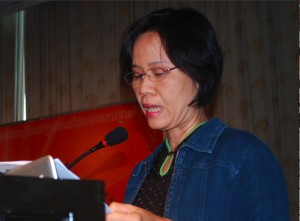By Marwaan Macan-Markar
CHIANG MAI, Thailand, Dec 12 (TerraViva) – When it comes to reporting about their neighbouring countries, journalists in Thailand’s mainstream media display a national security bias, often presenting a distorted view of reality and reflecting some prejudices against them.The ongoing diplomatic spat between wealthier Thailand and its less affluent eastern neighbour Cambodia, a country with which
it has had a chequered history, is a vivid example where the Thai media has “contributed to the problem,” Puangthong Pawakapan, assistant professor at the department of international relations at Chulalongkorn University in Bangkok, told the just-finished Mekong Media Forum here.
The forum, organised by IPS Asia-Pacific and the Philippine-based Probe Media Foundation, brought together more than 220 media professionals, notably journalists, and other participants from the six Mekong countries.
“The Thai media revealed a lack of professionalism in reporting about the Preah Vihear temple dispute,” said Puangthong Pawakapan, assistant professor at the department of international relations at Bangkok’s Chulalongkorn University. “Misinformation fed the feelings in most Thai press reports.”
“The media displayed a very nationalistic streak,” added Puangthong. “As long as the Thai media adopt a nationalistic view and refuse to investigate all the available documents related to the temple issue, they are part of the obstacles to a peaceful solution to the Thai-Cambodia problem.”
Preah Vihear is the 10th-century Hindu temple at the heart of this latest dispute between the South-east Asian neighbours, and has fired nationalistic passions in both countries. The Preah Vihear temple sits on the edge of a steep cliff along the Thai-Cambodian border.
Thai anger burst to the surface following a decision in July last year by the World Heritage Committee to recognise Preah Vihear as a world heritage site. The committee also recognised a 1962 ruling by the International Court of Justice that the temple was within Cambodian territory.
The tension saw a spike in troop strength along this border area, where the Thai and Cambodian military have faced each other down before. In April this year, soldiers from both countries exchanged gunfire, leaving three people dead.
The temple sits adjacent to a small parcel of land that still remains a disputed area, with both Bangkok and Phnom Penh staking claims to it. The Thai media did not report the burning down by Thais of Cambodian shop-houses in this disputed territory after tensions arose last year, Puangthong recounted.
Thai feelings of “not wanting to be humiliated by Cambodia’s victory” over the temple also shaped Thai media coverage following Cambodian Prime Minister Hun Sen’s decision in November to appoint former Thai prime minister Thaksin Shinawatra as his economic advisor, added Puangthong.
Thaksin is a political nemesis of the current Thai government and a reviled figure of a right-wing, conservative, pro-royalist protest movement that has used the Preah Vihear issue and Thaksin’s new ties with Cambodia to stoke anti-Cambodian sentiments.
This new role for Thaksin, who was ousted in a 2006 military coup and who has lived in exile to avoid a two-year jail term for a conflict of interest case, has seen relations between the two countries plummet. In early November, the Thai government withdrew its ambassador from Phnom Penh, which the Cambodians followed, and then went on to revoke an agreement for the exploration of oil and gas reserves in the Gulf of Thailand.
Reportage of migrant workers from Burma, Thailand’s western neighbour, also revealed “negative representation” in the media, said Soe Lin Aung of the Chiang Mai-based Migrant Assistance Programme Foundation, grassroots group that champions the rights of migrant workers. “They are portrayed as illegal and temporary yet deserving of pity.”
Here, too, a combination of history, nationalism and security concerns have combined into a cocktail that has often led to over two million Burmese migrant workers in Thailand being portrayed in a “humane way” and as important contributors to key sectors of the Thai economy, such as agriculture, construction and the fisheries.
Books, plays and stories have fed Thai perceptions that “Burma is the other, around which Thailand has developed its national consciousness,” said Soe Lin Aung. “Migrants from Burma are seen as a national security threat.”
Consequently, research on stories about Burmese migrant workers, who have fled their military-ruled country for low-paying jobs, shows that they are often portrayed as “criminals,” with accompanying “sensationalist headlines”.
Furthermore, a study of 1,200 media reports that appeared in 13 Thai-language newspapers between 2004 and 2006 had stories about migrant workers but they often quoted government officials, the police and employers, said Sutthida Malikaew, a freelance Thai journalist and researcher. “There were no views of the migrant workers.”
“The focus was from a security perspective,” she added, indicating how Thailand is “still haunted by the hatred between the two countries” when kings in previous centuries from both countries waged war and sacked historic capitals, such as what a Burmese king did in Thailand’s historic capital of Ayutthaya.
Little wonder why Burmese migrant workers have begun to respond to such negative portraits by responding in like manner – creating their own media outlets such as a community radio station in Chiang Mai. A newspaper articulating migrant workers’ perspectives is also being published in Mae Sot along the Thai-Burma border, a province home to tens of thousands of Burmese migrant workers.
“Migrant communities have begun to contest mainstream media representations,” said Soe Lin Aung. “They want to be seen as human beings.” (END/IPS/TV/AP/IP/HD/DV/MMM/TBB/JS/09)








